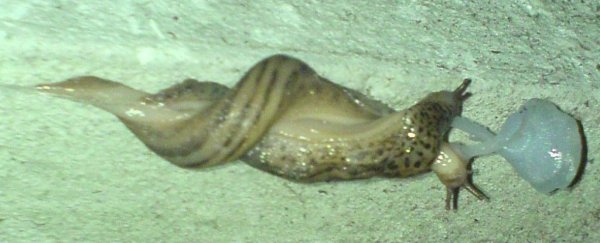Under the cover of night, two large leopard slugs begin to court, circling each other, before climbing single-file up a tree or onto a rock. They lower themselves on a mucus rope, while entwining their bodies in a strictly anti-clockwise fashion.
Both slugs then push out and entwine two overly-sized penises from openings on the side of their head, before exchanging sperm that may later fertilise each of their eggs.
Or, perhaps be eaten. Eventually, one slug crawls off and the other follows, eating the mucus trapeze as it goes.
The astonishing sex lives of leopard slugs, or Limax maximus, have long been recognised by naturalists and frequently feature in wildlife documentaries. But while their carnal dance has mesmerised millions, nobody knows why they mate in this most bizarre way.
This is because slug sex science has rarely attracted anything other than observational study. Fortunately for our curiosity, there are a few noble individuals who have taken time to understand the mating habits of snails and slugs, and whose research can give us some valuable clues.
It's well known that leopard slugs, like the majority of land-based snails and slugs, are hermaphrodites – meaning that both sexual organs are contained in the same individual. Yet, self-fertilisation is generally not the preferred option.
This is likely because natural selection favours mating with another individual to avoid the loss of health, fertility and fitness associated with inbreeding.
Even though they can choose whether to mate as male or female, most slugs and snails mate as male and female at the same time. They can also store sperm for months and even years, and so don't always need to receive sperm if they have previously mated with a better partner.
They can have the best of both worlds by choosing to eat and digest most of the sperm, while retaining just enough to fertilise their eggs.
We also know why leopard slugs turn anti-clockwise when mating. Just like human hearts are nearly always to the left hand side in our bodies, a slug's body is also asymmetric.
This is most obvious during mating, when the genitals emerge from the right side of the head. This asymmetry makes leopard slugs turn anti-clockwise in synchrony during courting and mating – and is also what made rare left-coiling snail Jeremy a media sensation in his/her search for love.
The rest is mystery
The rest of their elaborate mating behaviour is less well understood. It might be that that communication and cooperation are important aspects of sexual behaviour in the mollusc world, beginning with the head-to-tail trail-following.
The long mucus trapeze could be an example of sexual evolution going into overdrive to signify commitment to what's to come, making sure that any mating efforts won't be wasted.
The spiral entwinement between mating slugs may also facilitate close physical contact and commitment, minimising the risk of sudden withdrawal.
But this behaviour is also more sinister than it first appears. Some slugs and snails engage in hormone warfare or sexual conflict to increase their chances of fertilising their mate.
For example, as artistically interpreted by Isabella Rossellini, many snails (including the common garden variety) stab each with love-darts, transferring hormones to improve the chances that sperm are used for fertilisation.
The field slug Deroceras, seen below, flicks and strokes its partner with what looks like a sticky slug blanket for the same reason.
The leopard slug's beautiful entwinement could be another manifestation of this sexual coercion, maximising surface area for hormone transfer. The long penises – which can be 60 to 90 centimetres long in one Italian version of the leopard slug – may also be another extreme result of an evolutionary arms race to improve the prospects of fertilisation.
Why they intertwine so intricately is another matter. It could be that the beautiful complexity makes it more difficult for one slug to "cheat" by giving sperm and then not receiving some in return.
In the absence of direct study, the above explanations can only be considered speculation. The truth is that science doesn't yet have a firm handle on the fascinating sex rituals of leopard slugs.
More than voyeurism
Scientists are not just being voyeuristic when we say we'd like to unravel the mysteries of slug sex. Aside from just understanding the wonder and beauty of the behaviour, there are potential benefits.
Some species of slugs are farm and garden pests, eating holes in leaves, stems, flowers, tubers and bulbs and causing particular damage to new growth.
With the pending ban of key pesticides for agricultural use in some countries, including the active ingredient in slug pellets, there is growing pressure to find other ways to control their spread.
One way could be to identify otherwise harmless chemicals that interfere with their sex lives. A contraceptive sheath for slugs, so to speak.
Another approach could be to question why some of the slugs that cause the most agricultural nuisance forgo sex completely, especially in northern latitudes. Lack of sex reduces genetic variation, which causes crops such as potatoes and bananas to suffer from disease outbreaks.
Studying the self-contained reproductive habits of slugs may reveal a similar vulnerability that could be exploited to control their numbers.
There may of course also be benefits which we can't anticipate. So just as people champion trees, bees and butterflies, we need more slug enthusiasts of all kinds to help unravel their mucosal mysteries, including backyard explorers who can contribute to citizen science studies.
Of course, if you are already a convert, then how about a leopard slug sex ornament for the Christmas tree? ![]()
Angus Davison, Associate Professor and Reader in Evolutionary Genetics, University of Nottingham
This article is republished from The Conversation under a Creative Commons license. Read the original article.
